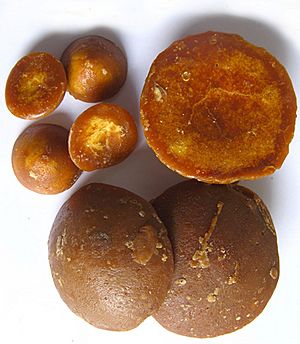Coconut sugar facts for kids
Coconut sugar is a natural sweetener. It's also called coco sugar or coconut palm sugar. This sugar comes from the sap of coconut palm trees. Think of sap as the sweet liquid inside the plant.
Many different types of palm trees can make sugar. Besides coconut palms, sugar can come from date palms or sago palms. Coconut sugar is used in many countries. It sweetens food and drinks, just like regular sugar.
Contents
How Coconut Sugar is Made
Coconut sugar can be found in different forms. It comes as crystals, granules, solid blocks, or even as a liquid syrup.
Making coconut sugar is a two-step process. First, farmers "tap" the coconut tree. They make a cut on the flower bud stem. This cut lets the sweet sap flow out. The sap drips into special bamboo containers.
Next, the collected sap is put into large cooking pots. These pots are heated to make the water in the sap evaporate. The sap is mostly water, about 80%. As the water leaves, the sap gets thicker. It turns into a thick, sweet syrup. This syrup can then be made into crystals, blocks, or a soft paste. The brown color of the sugar comes from a process called caramelization. This happens as the sap cooks down.
Cooking with Coconut Sugar
Coconut sugar is used in many kitchens around the world.
In Sri Lanka, people use coconut sugar as a syrup or a solid block called jaggery. They call it pol hakuru.
In Indonesian cuisine, coconut sugar is very popular. It's known as gula jawa, which means Javanese sugar. It's also called gula merah, meaning red sugar. Some famous Indonesian foods use coconut sugar. These include kecap manis, a sweet soy sauce, and dendeng, a type of meat dish.
Gula melaka is a name for palm sugar in Southeast Asia. It often comes from coconut palms. This sugar is used in many sweet desserts and cakes in the region. It can also be found in some savory dishes.
-
A bowl of gula melaka sago
What Does Coconut Sugar Taste Like?
Coconut sugar has a subtle sweetness. It tastes a bit like brown sugar, with a hint of caramel flavor. Overall, its sweetness is similar to regular table sugar or brown sugar.
Since coconut sugar isn't heavily processed, its color, sweetness, and flavor can change. These differences depend on a few things. For example, the type of coconut tree, the season it was harvested, and how the sap was cooked down all play a role.
See also
 In Spanish: Azúcar de coco para niños
In Spanish: Azúcar de coco para niños






